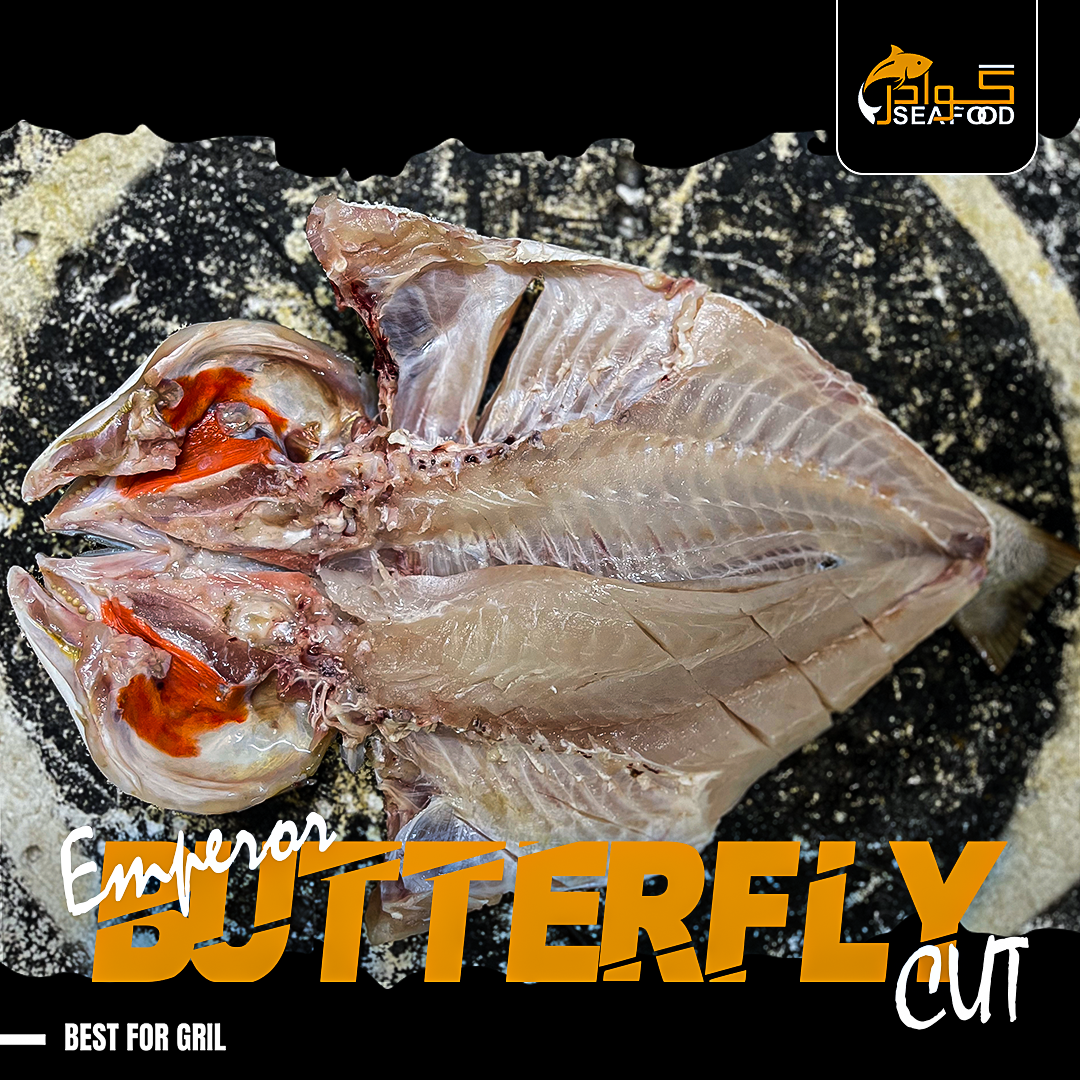Introduction
The Emperor Fish, scientifically known as Lethrinus nebulosus, is a distinguished species within the Lethrinidae family, commonly referred to as the emperors and emperor breams. This species is native to the Indo-West Pacific region, including the Arabian Sea, where it thrives in the warm, coastal waters. Characterized by its robust body and vibrant coloration, the Emperor Fish is highly esteemed both commercially and recreationally. Its firm, white flesh and mild, sweet flavor make it a prized catch among seafood enthusiasts. The species’ adaptability to various habitats and its rich nutritional profile further contribute to its popularity.
Deep Dive: Habitat, Behavior & Diet
-
Habitat: The Emperor Fish inhabits a range of environments, including coral reefs, seagrass beds, mangrove swamps, and sandy or rocky bottoms at depths ranging from 10 to 75 meters.
-
Diet: This species is carnivorous, primarily feeding on mollusks, echinoderms, crustaceans, and polychaete worms.
-
Behavior: Emperor Fish are typically solitary or found in small groups. They are diurnal and exhibit strong territorial instincts. Juveniles often form large schools, providing protection from predators.
-
Reproduction: The species is a protogynous hermaphrodite, meaning individuals initially mature as females and later transition into males. Spawning occurs during the warmer months, often synchronized with lunar cycles, and involves forming spawning aggregations in specific offshore reef areas.
Concise Addition: Reproduction & Conservation
-
Spawning Season: Occurs during the warmer months, with timing varying depending on location.
-
Conservation Status: The Emperor Fish is currently listed as “Least Concern” by the IUCN Red List, indicating a stable population.
Names & Taxonomy
| Field | Value |
|---|---|
| Common Name | Emperor Fish |
| Local Name | Mulla |
| Scientific Name | Lethrinus nebulosus |
| Family | Lethrinidae |
| Order | Perciformes |
| Class | Actinopterygii |
| Phylum | Chordata |
Sourcing & Catching Method
-
Sourced From: Wild-caught from the coastal waters of the Arabian Sea, particularly along the coastlines of Sindh and Balochistan, Pakistan.
-
Fishing Method: Caught using sustainable techniques such as gillnets and bottom trawls.
-
Processing: Cleaned and processed the same day to ensure maximum freshness and quality.
-
Season: Available year-round, with peak catches from April to June.
Physical Traits & Texture
-
Shape: Elongated body with a slightly compressed profile; robust and muscular.
-
Flesh: Firm, moist, and flaky, making it ideal for various cooking methods.
-
Skin: Thick and resilient, holds together well during cooking.
-
Flavor Profile: Mild and sweet, with a subtle oceanic taste.
Size Options
-
Small: 200g – 500g (ideal for whole frying or grilling).
-
Medium: 500g – 1kg (perfect for curries, baking, or grilling).
-
Large: 1kg+ (ideal for whole roasting or family-sized servings).
Cutting Options & Approximate Yields
| Cut Style | Approx. Yield | Ideal Use |
|---|---|---|
| Whole (cleaned) | ~100% | Grilling, roasting, whole fry |
| Gutted only | ~85% | Curry cuts, grilling |
| Headless & Gutted | ~75% | Frying, grilling, quick curry |
| Sliced (bone-in) | ~60–65% | Tawa fry, masala grill, pan-seared |
| Boneless Fillets | ~35–40% | Grilling, fish cakes, stews |
Cooking Ideas – Light, Healthy & Flavorful
-
Grilled Emperor Fish: Marinate with lemon, garlic, and herbs, then grill until golden and smoky.
-
Mulla Fish Curry: Cooked in a coconut milk-based gravy, with spices like turmeric, coriander, and cumin.
-
Tawa Fried Mulla: Marinate fish slices with red chili, ginger-garlic paste, and shallow fry until crispy.
-
Baked Mulla with Garlic and Herbs: Baked whole with rosemary, lemon slices, and olive oil for a light, fragrant dish.
Tips for Selecting Fresh Mulla
-
Eyes: Clear and bright, not cloudy.
-
Skin: Silvery and shiny, with no discoloration or dry patches.
-
Flesh: Firm and slightly elastic to the touch, not mushy.
-
Smell: Fresh ocean scent, not sour or overly fishy.
Storage Tips
-
Refrigeration: Keep below 4°C and consume within 1–2 days.
-
Freezing: Store in airtight containers for up to 1 month.
-
Marinated Fish: Can be frozen and cooked directly from the freezer.
Ideal Pairings & Seasonings
| Category | Suggestions |
|---|---|
| Spices | Garlic, cumin, coriander, turmeric, lemon |
| Sides | Lemon rice, couscous, grilled vegetables |
| Drinks | Mint lassi, fresh lemonade, white wine |
Nutrition Highlights (Approx. per 100g, raw)
| Nutrient | Approx. Value |
|---|---|
| Calories | ~110–120 kcal |
| Protein | ~20g |
| Fat | ~3g |
| Omega-3 | ~0.2g |
| Iron | ~1mg |
| Vitamin B12 | ~2.5µg |
Need Something Similar?
-
Red Snapper: Milder flavor with a firmer texture.
-
Javelin Grunter: Delicate and flakier, ideal for light seasonings.

 Sea Fish
Sea Fish


Farooq jamal –
I wasn’t expecting it to be that fresh, fantastic 🤩 will shop again highly recommend to all the seafood lovers